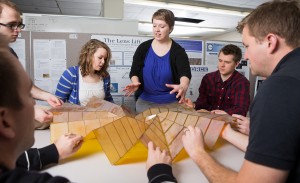Space may be huge, but astronauts are running out of room in the rockets that carry them there.
A group of BYU engineers has teamed up with physicist and world-renowned origami expert Robert Lang to produce solar arrays (or solar panels) for NASA that can be compacted for launch using careful folding techniques. Once in space, the solar array will expand to nearly 10 times its compacted size and generate power for space stations and satellites.
“It’s expensive and difficult to get things into space; you’re very constrained in space,” said BYU professor and research team leader Larry Howell in a press release. “With origami you can make it compact for launch and then as you get into space it can deploy and be large.”
Howell explained that the price of the rocket fuel requires the rocket to be as lightweight as possible in order for the craft to get into space, making the space-efficient designs BYU is working on valuable for future space exploration.

(Photo courtesy BYU News)
The team has been working on related projects employing origami techniques for several years, but the current project began while mechanical engineering graduate student Shannon Zirbel was an intern at NASA.
BYU had already been working with NASA through the Jet Propulsion Lab and found that BYU’s work with origami principles could be employed to design space-efficient solar arrays.
Howell received a $2 million research grant from the National Science Foundation to fund the project, which was featured in the November issue of the Journal of Mechanical Design.
Origami expert Lang has been involved in the project as a consultant since the fall of 2012 and has been happy to assist in creating more efficient designs for space exploration.
“I’ve enjoyed (working with the BYU engineers) very much,” he said. “They’re smart and enthusiastic and are working on interesting technologies. I couldn’t ask for more.”
Zirbel has also been involved with the research since fall 2012 and has been very instrumental in the design process.
“I have been able to work with lots of people who are experts in the field; that’s been really exciting,” she said. “I have been able to make a lot of great connections with people who really have a lot of experience.”
According to BYU News, the solar array developed by the group can be folded tightly down to a diameter of 2.7 meters and unfolded to its full size of 25 meters across. The group intends to create an array that can produce 250 kilowatts of power.
The group will work with NASA for several more years, and once the project is completed, they intend to continue exploring possible designs of earth-bound solar panels for use by the military and outdoor enthusiasts.
“I think it’s likely that the technologies we develop will have unanticipated spin-off benefits in other fields,” Lang said. “That’s the nature of research.”




